Effect of High Ti Contents on Austenite Microstructural Evolution During Hot Deformation in Low Carbon Nb Microalloyed Steels
Abstract
:1. Introduction
2. Materials and Methods
3. Results
3.1. Initial Precipitation and Microstructural State
3.2. Softening Kinetics
3.3. Strain-Induced Precipitation Behavior
3.4. Recrystallized Grain Size
3.5. Grain Growth Behavior
4. Discussion
4.1. Initial Microstructural and Precipitation State
4.2. Static Softening and Strain-Iduced Precipitation Behavior
4.3. Recrystallized Grain Size
4.4. Grain Growth Behavior
5. Conclusions
Author Contributions
Funding
Conflicts of Interest
References
- Andrade, H.L.; Akben, M.G.; Jonas, J.J. Effect of Molybdenum, Niobium, and Vanadium on Static Recovery and Recrystallization and on Solute Strengthening in Microalloyed Steels. Metall. Trans. A 1983, 14, 1967–1977. [Google Scholar] [CrossRef]
- Medina, S.F.; Quispe, A. Improved Model for Static Recrysallization Kinetics of Hot Deformed Austenite in Low Alloy and Nb/V Microalloyed Steels. ISIJ Int. 2001, 41, 774–781. [Google Scholar] [CrossRef]
- Fernandez, A.I.; Uranga, P.; López, B.; Rodriguez-Ibabe, J.M. Static Recrystallization Behaviour of a Wide Range of Austenite Grain Sizes in Microalloyed Steels. ISIJ Int. 2000, 40, 893–901. [Google Scholar] [CrossRef]
- Aretxabaleta, Z.; Pereda, B.; Lopez, B. Multipass Hot Deformation Behaviour of High Al and Al-Nb Steels. Mater. Sci. Eng. A 2014, 600, 37–46. [Google Scholar] [CrossRef]
- Bengochea, R.; Lopez, B.; Gutierrez, I. Influence of the Prior Austenite Microstructure on the Transformation Products obtained for C-Mn-Nb Steels after Continuous Cooling. ISIJ Int. 1999, 39, 583–591. [Google Scholar] [CrossRef] [Green Version]
- DeArdo, A.J. Niobium in Modern Steels. Int. Mater. Rev. 2013, 48, 371–402. [Google Scholar] [CrossRef]
- Wolczynski, W. Back-Diffusion in Crystal Growth. Eutectics. Arch. Metall. Mater. 2015, 60, 2403–2407. [Google Scholar] [CrossRef]
- Wolczynski, W. Back-Diffusion in Crystal Growth. Peritectics. Arch. Metall. Mater. 2015, 60, 2409–2414. [Google Scholar] [CrossRef]
- Himemiya, T.; Wolczynski, W. Solidification Path and Solute Redistribution of an Iron-Based MultiComponent Allow with Solute Diffusion in the Solid. Mater. Trans. 2002, 43, 2409–2414. [Google Scholar] [CrossRef]
- Medina, S.F.; Chapa, P.; Valles, A.; Quispe, M.I.; Vega, M.I. Influence of Ti and N Contents on Austenite Grain Control and Precipitate Size in Structural Steels. ISIJ Int. 1999, 39, 930–936. [Google Scholar] [CrossRef]
- Lagneborg, R.; Siwecki, T.; Zajac, S. Role of Vanadium in Microalloyed Steels. Scand. J. Metall. 1999, 28, 186–241. [Google Scholar]
- Sanz, L.; Pereda, B.; Lopez, B. Effect of Thermomechanical Treatment and Coiling Temperature on the Strengthening Mechanisms of Low Carbon Steels Microalloyed with Nb. Mater. Sci. Eng. A 2017, 685, 377–390. [Google Scholar] [CrossRef]
- Iza-Mendia, A.; Altuna, M.A.; Pereda, B.; Gutierrez, I. Precipitation of Nb in Ferrite after Austenite Conditioning. Part I: Microstructural Characterization. Metall. Trans. A 2012, 43, 4553–4570. [Google Scholar] [CrossRef]
- Altuna, M.A.; Iza-Mendia, A.; Gutierrez, I. Precipitation of Nb in Ferrite after Austenite Conditioning. Part II: Strengthening Contribution in High-Strength Low-Alloy (HSLA) Steels. Metall. Mater. Trans. A 2012, 43, 4571–4586. [Google Scholar] [CrossRef] [Green Version]
- Freeman, S.; Honeycombe, R.W.K. Strengthening of Titanium Steels by Carbide Precipitation. Met. Sci. 1977, 11, 59–64. [Google Scholar] [CrossRef]
- Funakawa, Y.; Shiozaki, T.; Tomita, K.; Yamamoto, T.; Maeda, E. Development of High Strength Hot-Rolled Sheet Steel consisting of Ferrite and Nanometer-Sized Carbides. ISIJ Int. 2004, 44, 1945–1951. [Google Scholar] [CrossRef]
- Bu, F.Z.; Wang, X.M.; Yang, S.W.; Shang, C.J.; Misra, R.D.K. Contribution of Interphase Precipitation on Yield Strength in Thermomechanically Simulated Ti-Nb and Ti-Nb-Mo Microalloyed Steels. Mater. Sci. Eng. A 2015, 620, 22–29. [Google Scholar] [CrossRef]
- Chen, C.Y.; Yen, H.W.; Kao, F.H.; Li, W.C.; Huang, C.Y.; Yang, J.R.; Wang, S.H. Precipitation Hardening of High-Strength Low-Alloy Steels by Nanometer-Sized Carbides. Mater. Sci. Eng. A 2009, 449, 162–166. [Google Scholar] [CrossRef]
- Chen, J.; Wang, J.D. Precipitation Characteristics in a Low-Carbon Vanadium-Titanium-Bearing Steel. Steel Res. Int. 2015, 86, 821–824. [Google Scholar] [CrossRef]
- Garcia-Sesma, L.; Lopez, B.; Lopez, B.; Pereda, B. Effect of Coiling Conditions on the Strengthening Mechanisms of Nb Microalloyed Steels with High Ti Addition Levels. Mater. Sci. Eng. A 2019, 748, 386–395. [Google Scholar] [CrossRef]
- Patra, P.K.; Sam, S.; Singhai, M.; Hazra, S.S.; Ram, G.D.J.; Bakshi, S.R. Effect of Coiling Temperature on the Microstructure and Mechanical Properties of Hot-Rolled Ti-Nb Microalloyed Ultra High Strength Steel. Trans. Indian Inst. Met. 2017, 70, 1773–1781. [Google Scholar] [CrossRef]
- Hodgson, P.D.; Gibbs, R.K. A Mathematical Model to Predict the Mechanical Properties of Hot Rolled C-Mn and Microalloyed Steels. ISIJ Int. 1992, 32, 1329–1338. [Google Scholar] [CrossRef] [Green Version]
- Pereda, B.; Rodriguez-Ibabe, J.M.; Lopez, B. I Improved Model of Kinetics of Strain Induced Precipitation and Microstructure Evolution of Nb Microalloyed Steels during Multipass Rolling. ISIJ Int. 2008, 48, 1457–1466. [Google Scholar] [CrossRef] [Green Version]
- Akben, M.G.; Chandra, T.; Plassiard, P.; Jonas, J.J. Dynamic Precipitation and Solute Hardening in a Titanium Microalloyed Steel Containing Three Levels of Manganese. Acta Metall. 1984, 32, 591–601. [Google Scholar] [CrossRef]
- Liu, W.J.; Jonas, J.J. A Stress Relaxation Method for Following Carbonitride Precipitation in Austenite at Hot Working Temperatures. Metall. Trans. A 1988, 19, 1403–1413. [Google Scholar] [CrossRef]
- Liu, W.J.; Jonas, J.J. Ti(CN) Precipitation in Microalloyed Austenite during Stress Relaxation. Metall. Trans. A 1988, 19, 1415–1424. [Google Scholar] [CrossRef]
- Wang, Z.; Mao, X.; Yang, Z.; Sun, X.; Yong, Q.; Li, Z.; Wen, Y. Strain-induced Precipitation in a Ti Micro-Alloyed HSLA Steel. Mater. Sci. Eng. A 2011, 529, 459–467. [Google Scholar] [CrossRef]
- Wang, Z.; Sun, X.; Yang, Z.; Yong, Q.; Zhang, C.; Li, Z.; Weng, Y. Effect of Mn Concentration on the Kinetics of Strain Induced Precipitation in Ti Microalloyed Steels. Mater. Sci. Eng. A 2013, 561, 212–219. [Google Scholar] [CrossRef]
- Hong, S.G.; Kang, K.B.; Park, C.G. Strain-induced Precipitation of NbC in Nb and Nb-Ti Microalloyed HSLA Steels. Scripta Mater. 2002, 46, 163–168. [Google Scholar] [CrossRef]
- Okaguchi, S.; Hashimoto, T. Computer Model for Prediction of Carbonitride Precipitation during Hot Working in Nb-Ti Bearing HSLA Steels. ISIJ Int. 1992, 32, 283–290. [Google Scholar] [CrossRef] [Green Version]
- Fernandez, A.I.; Lopez, B.; Rodriguez-Ibabe, J.M. Relationship Between the Austenite Recrystallized Fraction and the Softening Measured from the Interrupted Torsion Test Technique. Scripta Mater. 1999, 40, 543–549. [Google Scholar] [CrossRef]
- Llanos, L.; Pereda, B.; Lopez, B. Interaction Between Recovery, Recrystallization and NbC Strain-Induced Precipitation in High-Mn Steels. Metall. Mater. Trans. A 2015, 46, 5248–5265. [Google Scholar] [CrossRef]
- Bechet, S.; Beaujard, L. New Reagent for the micrographical demonstration of the austenite grain of hardened or hardened-tempered steels. Rev. Met. 1955, 52, 830–836. [Google Scholar] [CrossRef]
- Andersson, J.O.; Helander, T.; Höglund, L.; Shi, P.F.; Sundman, B. Thermo-Calc and DICTRA, Computational Tools for Materials Science. Calphad 2002, 26, 273–312. [Google Scholar] [CrossRef]
- Thermo-Calc Software. TCFE9 Steels/Fe-Alloys Database; Thermo-Calc Software: Solna, Sweden.
- Hua, M.; Garcia, C.I.; DeArdo, A.J. Multi-phase Precipitates in Interstitial-Free Steels. Scripta Metall. Mater. 1993, 28, 973–978. [Google Scholar] [CrossRef]
- Pereda, B.; Lopez, B.; Rodriguez-Ibabe, J.M. Increasing the Non-Recrystallization Temperature of Nb Microalloyed Steels by Mo Addition. In Proceedings of the International Conference on Microalloyed Steels: Processing, Microstructure, Properties and Performance Proceedings, Pittsburgh, PA, USA, 16–19 July 2007; pp. 151–159. [Google Scholar]
- Pereda, B.; Aretxabaleta, Z.; Lopez, B. Softening Kinetics in High Al and High Al-Nb-Microalloyed Steels. J. Mater. Eng. Perform. 2015, 24, 1279–1293. [Google Scholar] [CrossRef]
- Larrañaga-Otegui, A.; Pereda, B.; Jorge-Badiola, D.; Gutierrez, I. Austenite Static Recrystallization Kinetics in Microalloyed, B. Steels. Metall. Mater. Trans. A 2016, 47, 3150–3164. [Google Scholar] [CrossRef]
- Llanos, L.; Pereda, B.; Lopez, B.; Rodriguez-Ibabe, J.M. Modelling of Static Recrystallization Behavior of High Manganese Austenitic Steels with Different Alloying Contents. ISIJ Int. 2016, 56, 1038–1047. [Google Scholar] [CrossRef]
- Dutta, B.; Palmiere, E.J.; Sellars, C.M. Modelling the Kinetics of Strain Induced Precipitation in Nb Microalloyed Steels. Acta Mater. 2001, 49, 785–794. [Google Scholar] [CrossRef]
- Nagata, M.T.; Speer, J.G.; Matlock, D.K. Titanium Nitride Precipitation Behaviour in Thin-Slab Cast High-Strength Low-Allow Steels. Metall. Mater. Trans. A 2002, 33, 3099–3110. [Google Scholar] [CrossRef]
- Abad, R.; Fernandez, A.I.; Lopez, B. Interaction Between Recrystallization and Precipitation during Multipass Rolling in a Low Carbon Niobium Microalloyed Steel. ISIJ Int. 2001, 41, 1373–1382. [Google Scholar] [CrossRef] [Green Version]
- Sellars, C.M. Hot Working and Forming Processes. In Proceedings of the International Conference, Sheffield, UK, 17–20 July 1979; Sellars, C.M., Davies, G.J., Eds.; Metals Society: London, UK, 1980; pp. 3–15. [Google Scholar]
- Beynon, J.H.; Sellars, C.M. Modelling Microstructure and Its Effects during Multipass Hot Rolling. ISIJ Int. 1992, 32, 359–367. [Google Scholar] [CrossRef]
- Sellars, C.M.; Whiteman, J.A. Recrystallization and Grain Growth in Hot Working. Met. Sci. 1979, 13, 187–194. [Google Scholar] [CrossRef]
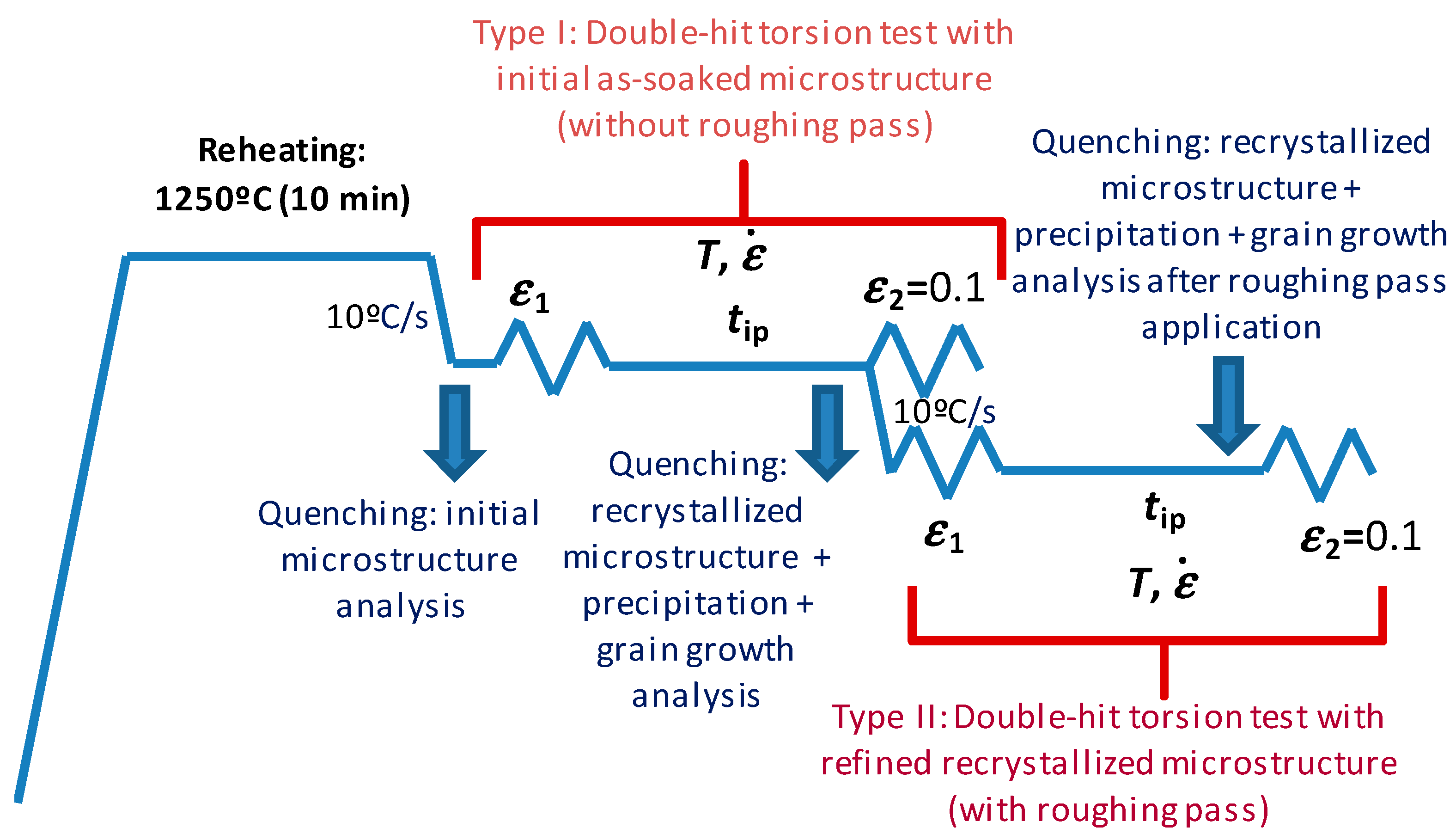

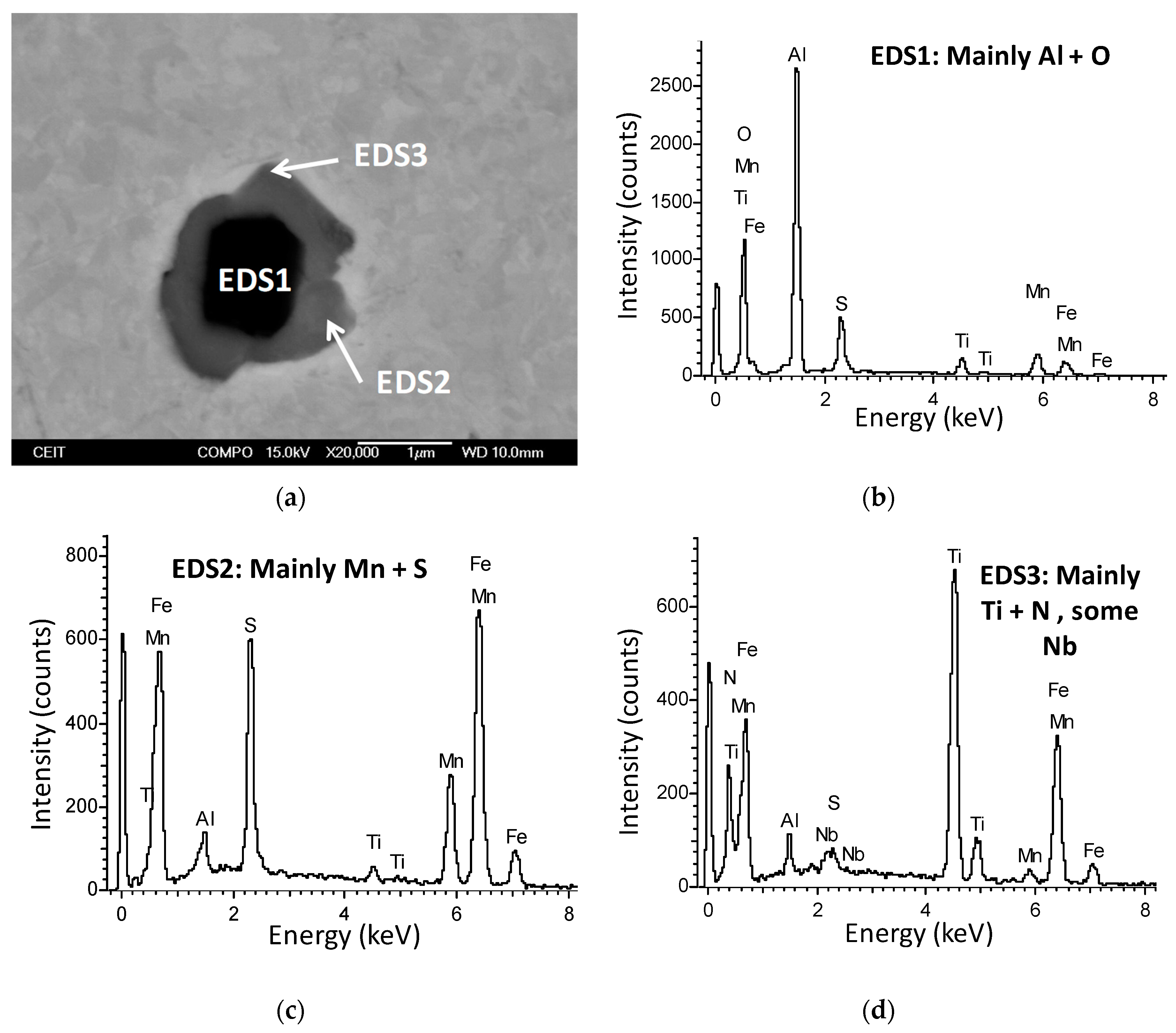
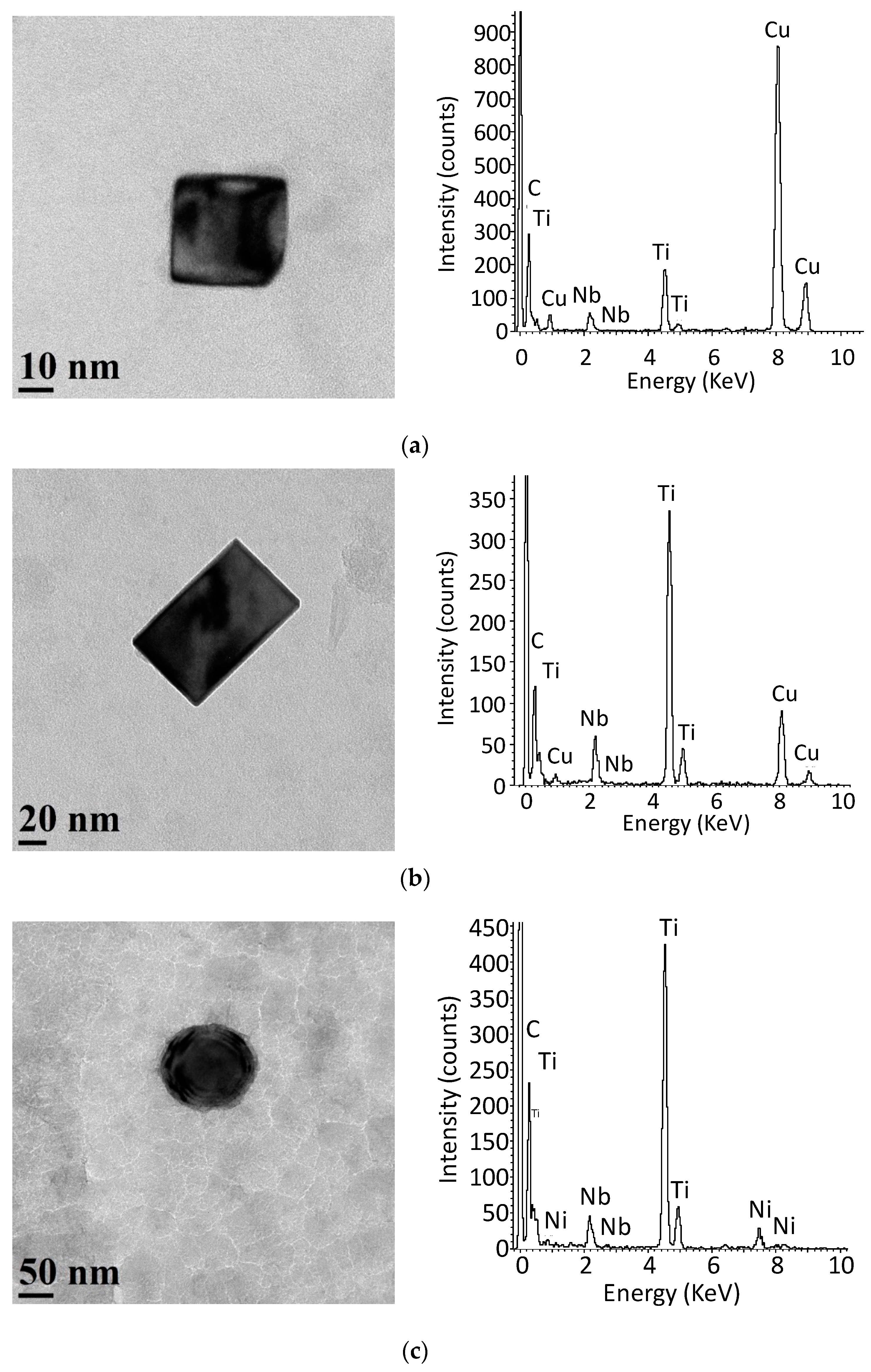
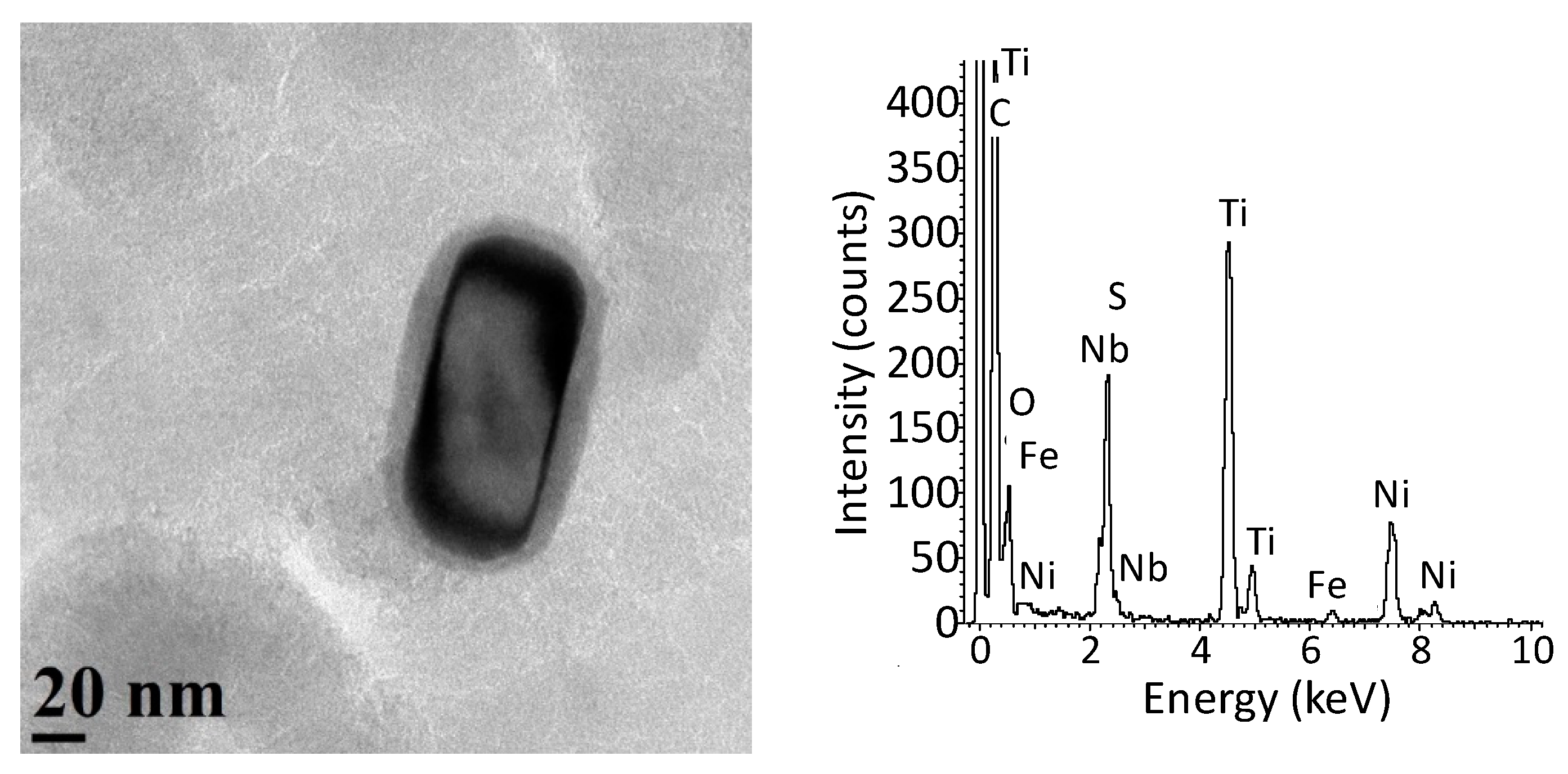
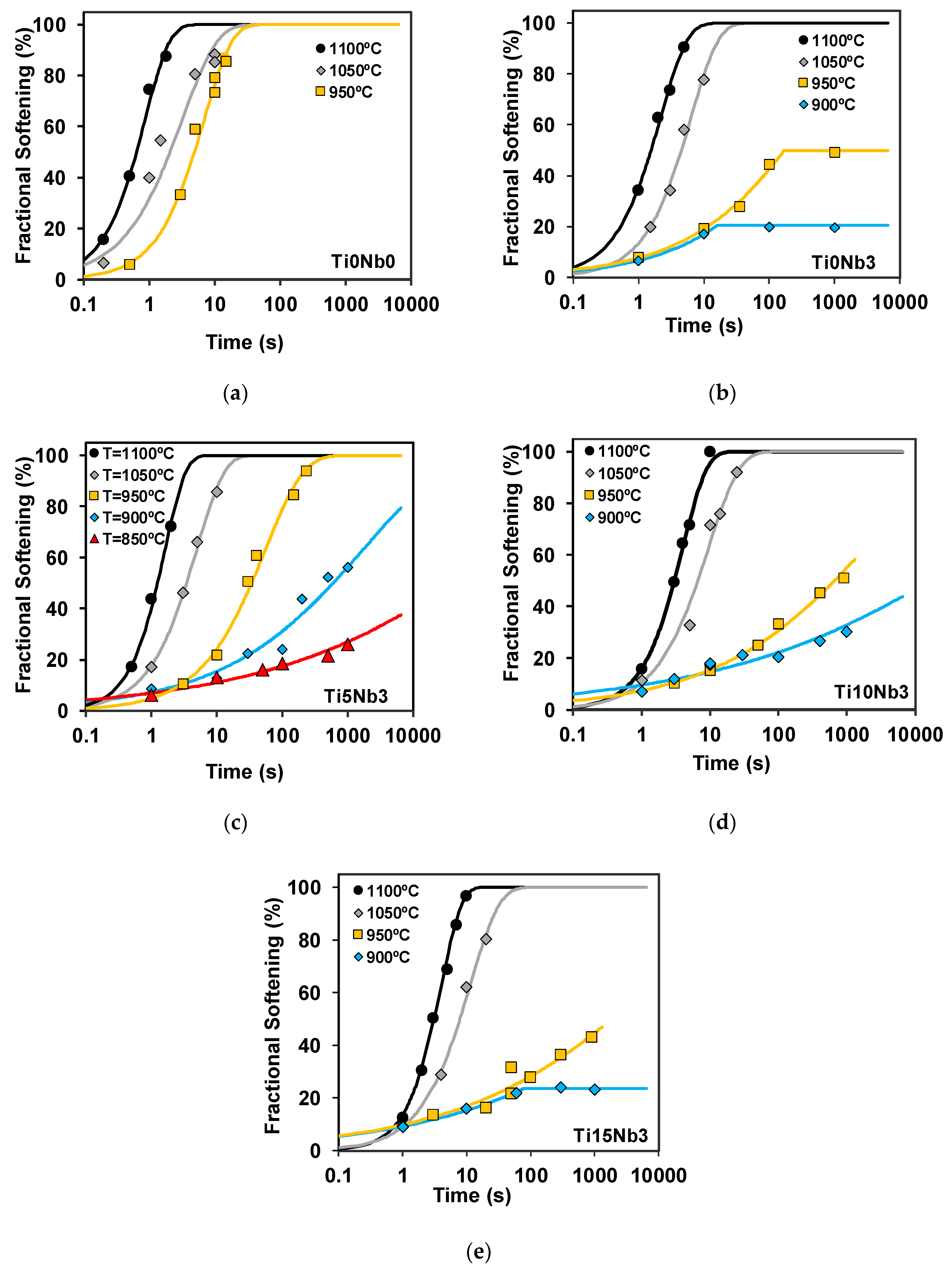
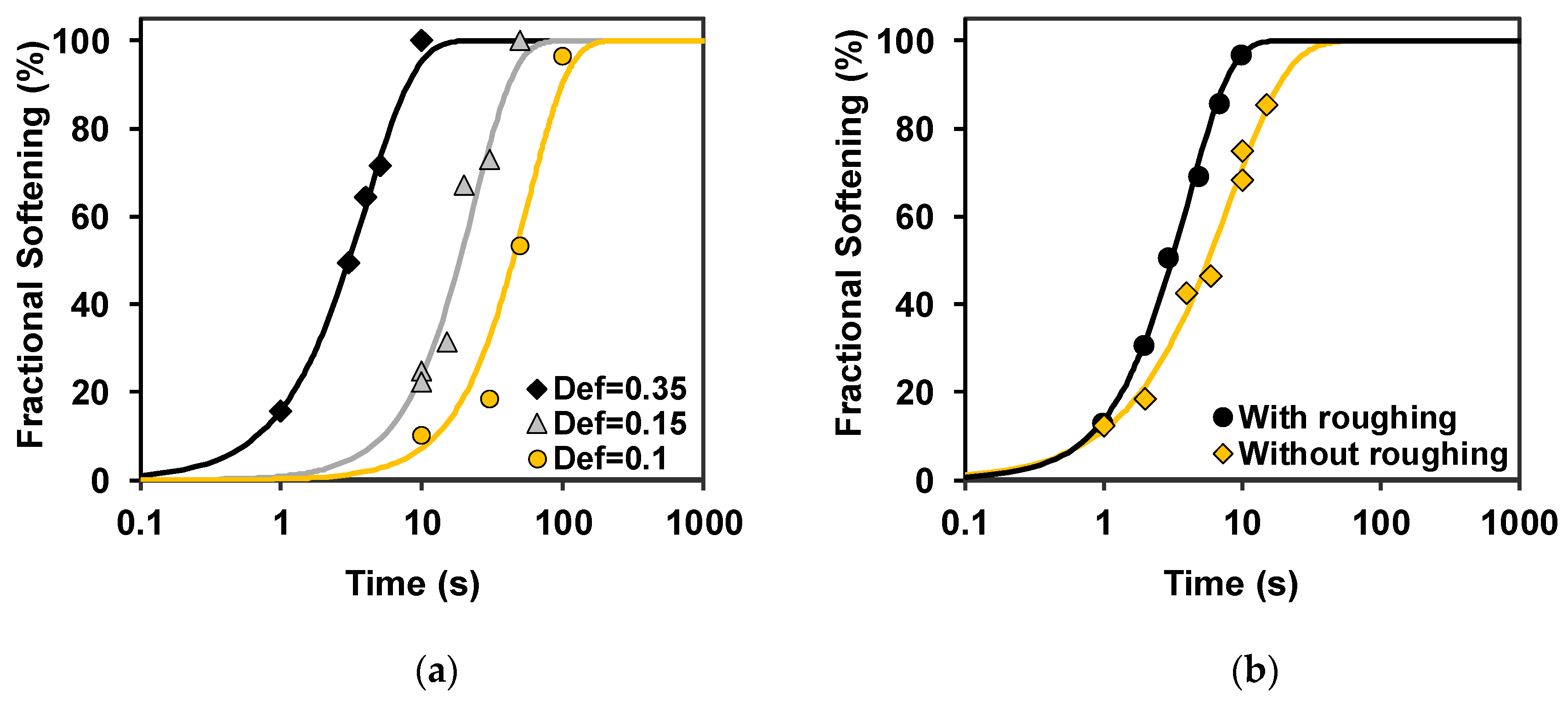




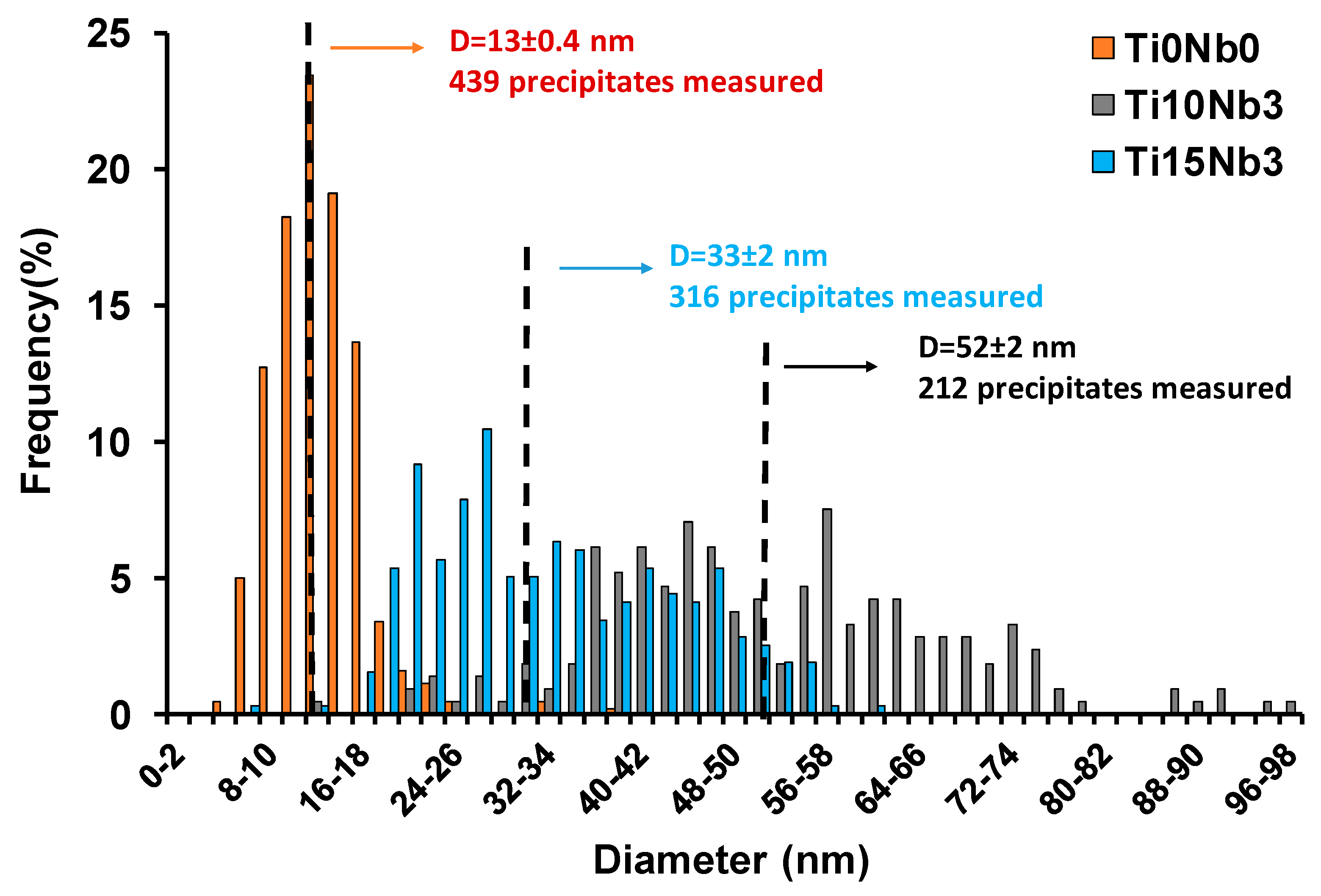
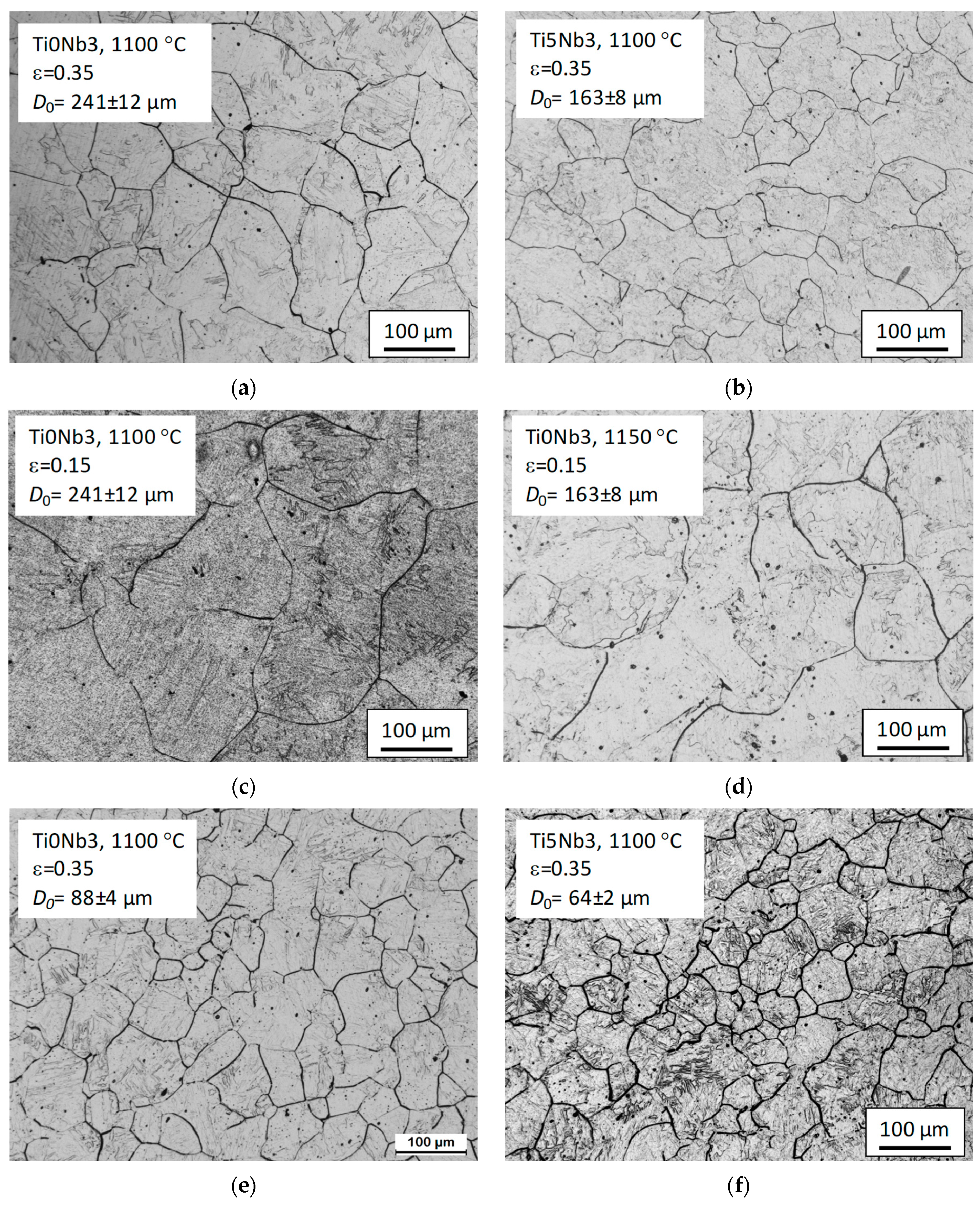





| Steel | C | Mn | Nb | Ti | P | S | Al | Si | Cr | Ni | N |
|---|---|---|---|---|---|---|---|---|---|---|---|
| Ti0Nb0 | 0.058 | 1.82 | 0.001 | 0.001 | 0.020 | 0.003 | 0.019 | 0.011 | 0.019 | 0.006 | 0.0064 |
| Ti0Nb3 | 0.059 | 1.79 | 0.033 | 0.003 | 0.020 | 0.003 | 0.036 | 0.026 | 0.013 | 0.005 | 0.0036 |
| Ti5Nb3 | 0.058 | 1.81 | 0.033 | 0.044 | 0.020 | 0.004 | 0.024 | 0.012 | 0.019 | 0.006 | 0.0064 |
| Ti10Nb3 | 0.059 | 1.80 | 0.034 | 0.091 | 0.021 | 0.003 | 0.036 | 0.016 | 0.017 | 0.006 | 0.0054 |
| Ti15Nb3 | 0.059 | 1.82 | 0.033 | 0.139 | 0.021 | 0.003 | 0.040 | 0.014 | 0.016 | 0.006 | 0.0054 |
| Condition | Ti0Nb0 | Ti0Nb3 | Ti5Nb3 | Ti10Nb3 | Ti15Nb3 |
|---|---|---|---|---|---|
| Grain size after Reheating (µm) | 230 ± 15 | 241 ± 12 | 163 ± 8 | 258 ± 4 | 193 ± 10 |
| Grain size with Roughing (µm) | 126 ± 4 | 88 ± 4 | 70 ± 2 | 114 ± 4 | 96 ± 3 |
| Steel | (μm) | Tdef (°C) | (s−1) | (μm) | Steel | (μm) | Tdef (°C) | (s−1) | (μm) | ||
|---|---|---|---|---|---|---|---|---|---|---|---|
| Ti0Nb0 | 0.35 | 230 ± 15 | 1100 | 1 | 126 ± 4 | Ti5Nb3 | 0.35 | 163 ± 8 | 1100 | 1 | 70 ± 2 |
| 0.35/0.35 | 126 ± 4 | 1100 | 1 | 62 ± 1 | 0.35 | 163 ± 8 | 1100 | 5 | 64 ± 2 | ||
| 0.35/0.35 | 126 ± 4 | 1050 | 1 | 70 ± 2 | 0.15 | 163 ± 8 | 1150 | 1 | 162 ± 9 | ||
| Ti0Nb3 | 0.35 | 241 ± 12 | 1100 | 1 | 88 ± 4 | 0.35/0.35 | 70 ± 2 | 1100 | 1 | 56 ± 1 | |
| 0.15 | 241 ± 12 | 1100 | 1 | 256 ± 14 | Ti10Nb3 | 0.35 | 258 ± 4 | 1100 | 1 | 114 ± 4 | |
| 0.35/0.35 | 88 ± 4 | 1100 | 1 | 65 ± 2 | 0.35/0.35 | 114 ± 4 | 1100 | 1 | 79 ± 2 | ||
| 0.35/0.35 | 88 ± 4 | 1050 | 1 | 69 ± 2 | Ti15Nb3 | 0.35 | 193 ± 10 | 1100 | 1 | 96 ± 3 | |
| - | - | - | - | - | - | 0.35/0.35 | 96 ± 3 | 1100 | 1 | 81 ± 2 | |
| - | - | - | - | - | - | 0.35/0.15 | 96 ± 3 | 1100 | 1 | 131 ± 7 |
| Microalloying Element | Ti0Nb3 | Ti5Nb3 | Ti10Nb3 | Ti15Nb3 |
|---|---|---|---|---|
| Nb(%) | 0.033 | 0.033 | 0.034 | 0.032 |
| Ti (%) | 0.001 | 0.012 | 0.044 | 0.073 |
| Steel | (μm) | Tdef (°C) | (s−1) | (s) | Steel | (μm) | Tdef (°C) | (s−1) | (s) | ||||
|---|---|---|---|---|---|---|---|---|---|---|---|---|---|
| Ti0Nb0 | 230 ± 15 | 0.35 | 1100 | 1 | 1.2 | 1.0 | Ti10Nb3 | 258 ± 4 | 0.35 | 1100 | 1 | 4.9 | 1.1 |
| 126 ± 4 | 0.35 | 1100 | 0.7 | 1.2 | 114 ± 4 | 0.35 | 1050 | 6.7 | 1.0 | ||||
| 0.15 | 1100 | 4.6 | 2.0 | 0.35 | 1100 | 3.0 | 1.3 | ||||||
| 0.35 | 1050 | 2.1 | 0.8 | 0.15 | 1100 | 18.6 | 1.5 | ||||||
| 0.35 | 950 | 5.0 | 1.0 | 0.1 | 1100 | 44.3 | 1.5 | ||||||
| Ti0Nb3 | 241 ± 12 | 0.35 | 1100 | 1 | 3.4 | 1.1 | Ti15Nb3 | 193 ± 10 | 0.35 | 1100 | 1 | 5.7 | 1.0 |
| 0.15 | 1100 | 23.1 | 0.9 | 96 ± 3 | 0.35 | 1050 | 7.9 | 1.0 | |||||
| 88 ± 4 | 0.35 | 1050 | 4.5 | 1.0 | 0.35 | 1100 | 3.1 | 1.4 | |||||
| 0.35 | 1100 | 1.6 | 1.1 | 0.15 | 1100 | 22.5 | 1.5 | ||||||
| 0.15 | 1100 | 11 | 1.4 | 0.1 | 1100 | 57.3 | 2.1 | ||||||
| 0.1 | 1100 | 14 | 2.5 | - | - | - | - | - | - | - | |||
| Ti5Nb3 | 163 ± 8 | 0.35 | 1100 | 1 | 2.4 | 1.2 | - | - | - | - | - | -- | |
| 0.35 | 1100 | 5 | 2.2 | 0.8 | - | - | - | - | - | - | - | ||
| 0.35 | 1150 | 1 | 1.6 | 1.0 | - | - | - | - | - | - | - | ||
| 0.15 | 1150 | 17.1 | 1.1 | - | - | - | - | - | - | - | |||
| 70 ± 2 | 0.35 | 950 | 34.1 | 0.7 | - | - | - | - | - | - | - | ||
| 0.35 | 1050 | 3.5 | 1.0 | - | - | - | - | - | - | - | |||
| 0.35 | 1100 | 1.2 | 1.4 | - | - | - | - | - | - | - | |||
| 0.15 | 1100 | 10.3 | 1.9 | - | - | - | - | - | - |
© 2020 by the authors. Licensee MDPI, Basel, Switzerland. This article is an open access article distributed under the terms and conditions of the Creative Commons Attribution (CC BY) license (http://creativecommons.org/licenses/by/4.0/).
Share and Cite
García-Sesma, L.; López, B.; Pereda, B. Effect of High Ti Contents on Austenite Microstructural Evolution During Hot Deformation in Low Carbon Nb Microalloyed Steels. Metals 2020, 10, 165. https://doi.org/10.3390/met10020165
García-Sesma L, López B, Pereda B. Effect of High Ti Contents on Austenite Microstructural Evolution During Hot Deformation in Low Carbon Nb Microalloyed Steels. Metals. 2020; 10(2):165. https://doi.org/10.3390/met10020165
Chicago/Turabian StyleGarcía-Sesma, Leire, Beatriz López, and Beatriz Pereda. 2020. "Effect of High Ti Contents on Austenite Microstructural Evolution During Hot Deformation in Low Carbon Nb Microalloyed Steels" Metals 10, no. 2: 165. https://doi.org/10.3390/met10020165





